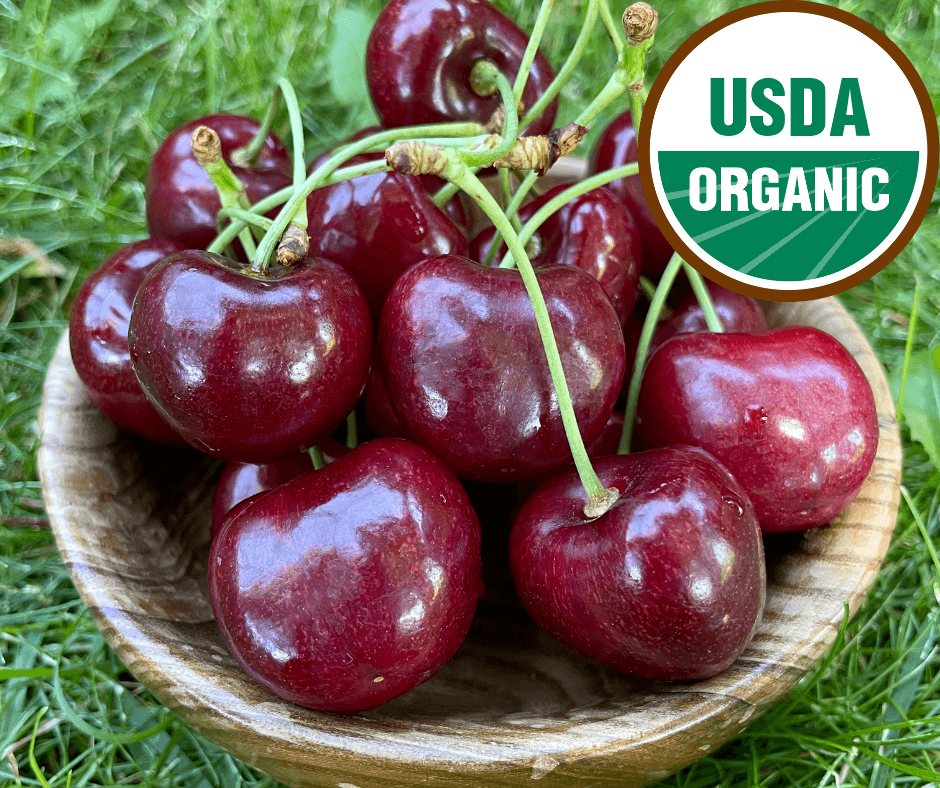Can GMOs be Organic?

The straightforward answer to “Can GMOs be organic?” is no. The National Organic Program (NOP) in the U.S. and the European Union’s organic regulations forbid the use of GMOs in organic farming. This topic sparks significant interest, as seen in popular searches.
The complexities of this question touch on essential agricultural practices, creating curiosity and confusion. Drawing on our 35 years of experience as organic farmers at Chelan Ranch Organics; we offer insights into the ongoing discussion between GMOs and organic principles. Join us as we explore why this intersection remains a crucial focus in sustainable and organic farming.
Agricultural systems encompass various practices, methods, and approaches for cultivating crops and raising livestock. These systems include conventional farming, organic farming (Chelan Ranch Organics), agroecology, permaculture, and more. GMOs are a tool within various agricultural systems to address specific challenges or goals. Challenges include increasing crop yields, reducing the need for chemical inputs, or improving crop resilience.
Distinguishing Between
The use of GMOs is a specific aspect of agricultural technology. GMO adoption depends on the goals and preferences of farmers, regulatory frameworks, and societal attitudes toward genetic engineering in agriculture. It’s important to distinguish between the technology of gene modification and the diverse agricultural systems. Determining when or if to use GMOs is easier when we can distinguish between the two realms.
The Definitions
To make this determination, we need to know what GMOs are. Genetically Modified Organisms (GMOs) are living beings whose genetic material is deliberately changed in a lab using biotechnological methods. The process involves precisely adjusting the DNA by adding specific genes, modifying existing ones, or removing unwanted traits. Genetic modification gives the organism the desired characteristics like pest resistance, herbicide tolerance, improved nutrition, or a more extended shelf. Such techniques like gene splicing, recombinant DNA technology, and CRISPR-Cas9 require precise molecular-level modifications. GMOs are used in agriculture, medicine, and industry. The topic sparks debates on GMO benefits and concerns about environmental impact, biodiversity, and human health.

Those concerns are why organic farming rejects the technology of GMOs. Organic is a holistic and sustainable approach to farming and food production, prioritizing natural and environmentally friendly practices. The focus is on promoting soil health, implementing crop rotation, and utilizing organic inputs. Organic farmers also need to avoid synthetic pesticides, herbicides, and fertilizers. The aim is to work harmoniously with the natural ecosystem. At the same time, biodiversity and minimizing the environmental impact of agricultural activities is a priority. Organic farming generally prohibits the use of genetically modified organisms (GMOs). The organic label on food products assures consumers that these principles produced the products. The emphasis is on a commitment to ecological balance, animal welfare, and producing wholesome, minimally processed foods.
Key Areas of Conflict
The fundamental conflict between GMOs (Genetically Modified Organisms) and organic farming principles lies in differing approaches to agriculture. Each has distinct philosophies, goals, and practices. The conflict centers on several key areas: genetic modification techniques, avoidance of synthetic inputs, ownership and control of seeds, consumer concerns, and transparency. We’ll review the key areas and compare each approach with an example.
Genetic Modification Techniques
GMOs: Genetic modification in GMOs involves the alteration of an organism’s genetic material. The process uses techniques like gene splicing, recombinant DNA technology, or CRISPR-Cas9. These modifications can include inserting genes from unrelated species to confer specific traits. Species that are considered unrelated typically belong to different taxonomic groups or lineages.
An example of genes inserted into different species is the development of Roundup Ready soybeans and corn. Developed in the 1990s, these genetically modified (GMO) crops resist the herbicide glyphosate. The GMO crops allow farmers to spray the herbicide on the entire crop to control weeds without harming the crops. However, widespread use led to glyphosate-resistant weeds, causing challenges for farmers. This weed resistance means using more herbicides and practices, going against the goal of simplifying weed control. Increased herbicide use has environmental impacts and raises concerns about the long-term sustainability of this biotechnological approach. As a consumer, I worry about the effects of consuming non-organic corn and soy treated with Roundup. Over 90% of U.S. corn, soybeans, and cotton are GMO, Roundup Ready varieties. Products using these crops aren’t labeled unless they’re organic or non-GMO. So, it’s crucial to check labels for clarity.

Organic Farming: Organic farming principles emphasize natural and traditional agricultural practices without synthetic inputs. Genetic modification, especially introducing genes from unrelated species, is generally inconsistent with these principles. However, the NOP does allow crossbreeding programs, which is a distinctly different approach to crop improvement in its methods, processes, and outcomes.
For example, traditional crossbreeding methods, such as selective breeding and hybridization, are used in crossbreeding programs. These methods have been employed for centuries and involve controlled pollination and selection of plants with desired traits. The University of Minnesota’s crossbreeding program developed Honeycrisp using controlled pollination and selecting parent plants Macoun and Honeygold.
Avoidance of Synthetic Inputs:
GMOs: Genetic engineering often involves the use of synthetic inputs. This includes laboratory techniques and sometimes the application of synthetic genetic material. An example is the CRISPR-Cas9 system. It is a revolutionary tool in genetic engineering. The technology uses synthetic RNA molecules and the Cas9 protein to cut and edit DNA sequences. This conflicts with the organic farming principle of avoiding synthetic inputs, including synthetic pesticides, herbicides, and fertilizers.
An example of using synthetic inputs and laboratory techniques in agriculture is the development of genetically modified (GM) crops with enhanced traits. One well-known example is Bt (Bacillus thuringiensis) cotton. In the development of Bt cotton, a gene from the bacterium Bacillus thuringiensis, which produces a protein toxic to certain insect pests, is inserted into the cotton plant’s genetic material. As the cotton plants grow, they express the pesticidal protein from Bacillus thuringiensis throughout their tissues. This protein is toxic to certain insect pests, providing built-in pest resistance. The GMO cotton has raised concerns about environmental impact, biodiversity, and the potential transfer of genes to wild plant populations.

Organic Farming: Organic agriculture relies on natural methods for pest control, soil fertility, and weed management. The goal is to work in harmony with natural ecosystems rather than relying on synthetic inputs that may have environmental and health concerns.
For example, Integrated Pest Management (IPM) is a holistic approach combining various pest control strategies. IPM includes monitoring pest populations, using natural predators, and employing cultural practices to create an environment less favorable to pests. By minimizing the need for chemical interventions, beneficial insect populations can thrive. We have purchased beneficial insects such as ladybugs for our organic cherry orchards with harmful aphid populations. Ladybugs are natural predators of aphids and other small insects, keeping their numbers in check without synthetic pesticides.
Preservation of Biodiversity:
GMOs: Introducing genetically modified crops, especially those resistant to pests or herbicides, may impact biodiversity by favoring specific traits. This can have consequences for ecosystems and non-target organisms.
For example, repeated use of Roundup on crops like corn and soybeans can impact biodiversity. When farmers use the same herbicide widely, it puts pressure on weed populations. Weeds not affected by the herbicide can survive and reproduce, leading to resistance. Over time, more weeds become resistant, changing the weed communities in fields. This shift can affect ecosystems by favoring certain plant species over others, impacting overall plant diversity. Less plant diversity means a negative ripple effect on herbivores, pollinators, and other organisms that rely on diverse plant communities. The widespread use of herbicide-resistant crops contributes to these changes.

Organic Farming: Organic principles prioritize biodiversity by promoting crop diversity, rotation, and the preservation of natural habitats. This approach aims to create resilient ecosystems that can adapt to environmental changes.
For example, combining crop diversity, rotation, and preserving natural habitats creates resilient ecosystems. The buffer strips surrounding our organic fields and orchards serve as refuges for beneficial insects, birds, and other wildlife. We add houses for predatory birds to protect our cherries and blueberries. Preserving these natural habitats contributes to overall biodiversity on the farm. Resilient ecosystems can better withstand environmental changes in a balanced and adaptive biological community.
Ownership and Control of Seeds:
GMOs: Developing and using genetically modified seeds are often associated with biotechnology companies with patents on specific genetic traits. This raises concerns about control and ownership of genetic resources.
For example, GMOs have significantly changed the seed and chemical industry in the U.S. Specifically, they led to consolidation, with a few big corporations like BASF, Bayer/Monsanto, ChemChina-Syngenta, and Corteva Agriscience dominating the market. These companies control over two-thirds of global seed and pesticide sales. This consolidation involves increased use of patents to protect intellectual property. The increased use of patents raises concerns about farmers’ rights and control over genetic resources. The introduction of herbicide-tolerant crops, like Roundup Ready varieties, has influenced the use of specific herbicides. This complex landscape involves regulatory challenges, resistance issues in pest populations, and changing consumer preferences for non-GMO products.

Organic Farming: Organic farming principles often support open-pollinated and heirloom varieties, encouraging farmers to save and exchange seeds. There is a focus on maintaining seed sovereignty and avoiding dependence on a few patented varieties.
For example, open-pollinated and heirloom seeds can be saved and replanted without losing their desired traits. In contrast, hybrid or genetically modified seeds cannot. Open-pollinated and heirloom seeds align with the organic principle of promoting biodiversity and sustainability. Organic farming values heirlooms like the Brandywine tomato, known for its unique flavor. Brandywine can produce seeds that growers can save and share. Organic farmers aim to preserve genetic diversity, adaptability, and resilience in crops by encouraging the cultivation and exchange of such seeds. This prevents reliance on a limited set of patented varieties and fosters a decentralized, farmer-driven seed system. This approach supports the broader goal of sustainable agriculture and preserving traditional farming practices.
Consumer Concerns and Transparency:
GMOs: Consumers are concerned about the safety and potential long-term health effects of genetically modified foods. This has led to calls for transparent labeling and clear information about the presence of GMOs in products. Several factors prevent GMO labeling: 1. Opposition from powerful biotechnology and food industries, such as the four listed above. 2. Establishing consistent regulatory standards has proven complex, and varying public perceptions of GMOs add to the challenge. 3. Global trade considerations, political dynamics, and concerns about costs and implementation logistics further complicate the issue. The GMO labeling debate involves balancing consumer rights, industry interests, and regulatory complexities.

Organic Farming: Organic products are often associated with consumer preferences for natural and minimally processed foods. Organic certification includes strict standards for the production and labeling of organic products.
For example, Organic certification entails stringent standards governing the production and labeling of organic products. The USDA Organic certification program outlines specific criteria for farmers and food producers in the United States. They must adhere to the criteria outlined to bear the organic label on their products. These standards include soil fertility management without synthetic pesticides or fertilizers, excluding genetically modified organisms (GMOs), humane animal treatment, and avoiding synthetic additives and irradiation. Organic certification involves rigorous inspections by accredited certifying agencies to ensure compliance with these standards throughout production. The certification not only assures consumers of the organic integrity of the products but also fosters transparency and trust in the organic industry.
What We’ve Learned
In navigating the intricate landscape of organic farming and genetic engineering, it becomes evident that the question of GMOs in organics is not just a simple yes or no. As we conclude this exploration, the firm stance of the National Organic Program and the European Union against GMOs in organic farming underscores the importance of maintaining the integrity of organic principles. The ongoing dialogue between these two realms reveals the complexities and nuances that shape the future of sustainable and organic agriculture. At Chelan Ranch Organics, our three and a half decades of hands-on experience have shown us that this intersection demands continuous scrutiny, thoughtful consideration, and a commitment to fostering agricultural practices that prioritize both environmental sustainability and the well-being of consumers. Join us as we remain dedicated to the ongoing conversation at the heart of sustainable and organic farming practices.